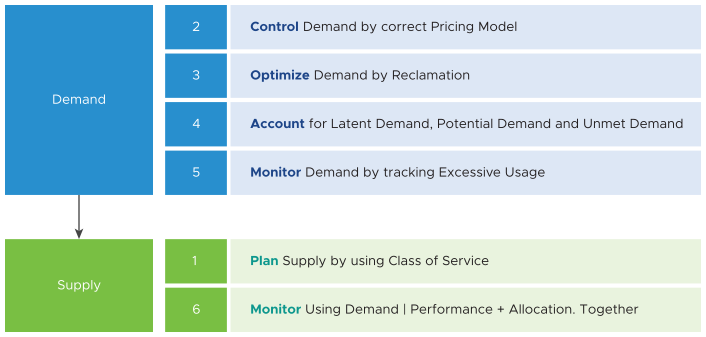Capacity quantifies the resources used, resources remaining, and opportunities to reclaim unused resources. Projections of the demand provide a proactive view of capacity. The Capacity Dashboards display capacity in terms of time remaining before capacity is projected to run out, the amount of capacity remaining, the number of VMs that might fit in the remaining capacity, and reclaimable resources that can increase the available capacity.
Capacity management is about balancing demand and supply. It is about meeting demand with the lowest possible cost.
For IaaS or DaaS, capacity management begins before the hardware is deployed. It begins with a business plan that defines what class of service will be provided. Each class of service, for example, gold, silver, bronze is differentiated by the quality of service and covers the availability, for example, 99.99% uptime for Gold, 99.95% uptime for Silver. It also covers performance, for example, 10 ms disk latency for Gold, 20 ms disk latency for Silver, and security or compliance.
The quality incurs cost and in turn drives price. Gold VM is higher per vCPU and per GB of RAM because it has a higher quality of service. A proper pricing model must be planned. If you want your customers to rightsize in advance, then a 64 vCPU VM has to be more than 64x the price of 1 vCPU VM. If the pricing model is a simple straight line, there is no incentive to go small and no penalty if it is over provisioned. In this case, you end up forcing rightsizing in production, which is a costly and time consuming process.

- Latent demand. Many critical VMs are protected with Disaster Recovery. During a Disaster Recovery drill or an actual disaster, this load is consumed.
- Potential demand. Many newly provisioned VMs take time to reach their expected demand. It takes time for the database to reach the full size, the user base to reach the target, and the functionalities to complete. When this is achieved, it results in the increase in demand.
- Unmet demand occurs when the VM or Kubernetes Pod is undersized. The load is running nearly 100% most of the time.
- Excessive demand can wreak havoc in a shared environment. A group of highly demanding VM can collectively impact overall performance of the cluster or datastore.